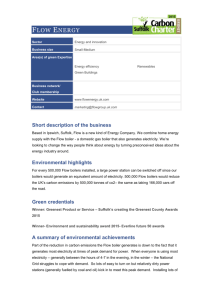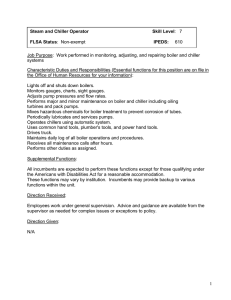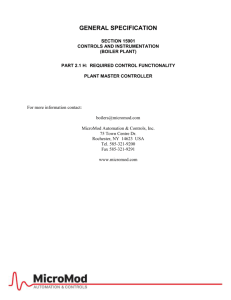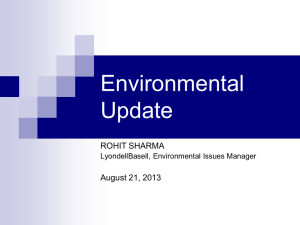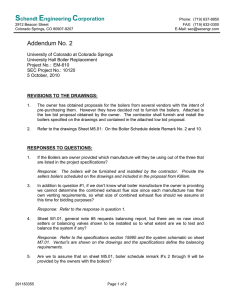8 AUG 2011
advertisement
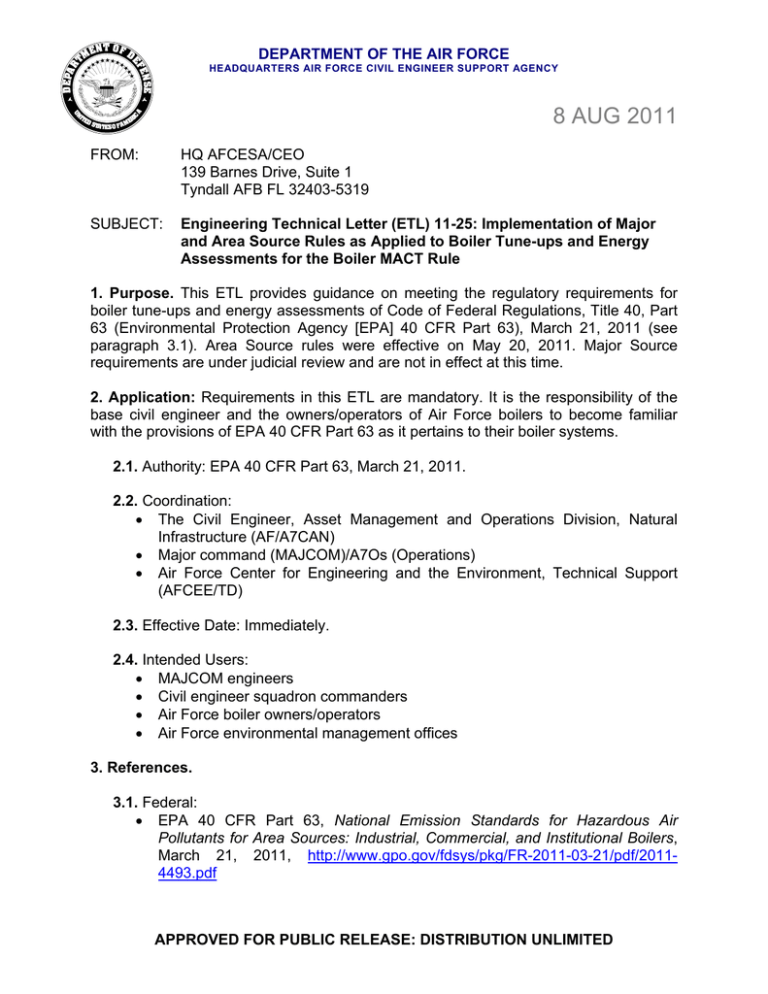
DEPARTMENT OF THE AIR FORCE HEADQUARTERS AIR FORCE CIVIL ENGINEER SUPPORT AGENCY 8 AUG 2011 FROM: HQ AFCESA/CEO 139 Barnes Drive, Suite 1 Tyndall AFB FL 32403-5319 SUBJECT: Engineering Technical Letter (ETL) 11-25: Implementation of Major and Area Source Rules as Applied to Boiler Tune-ups and Energy Assessments for the Boiler MACT Rule 1. Purpose. This ETL provides guidance on meeting the regulatory requirements for boiler tune-ups and energy assessments of Code of Federal Regulations, Title 40, Part 63 (Environmental Protection Agency [EPA] 40 CFR Part 63), March 21, 2011 (see paragraph 3.1). Area Source rules were effective on May 20, 2011. Major Source requirements are under judicial review and are not in effect at this time. 2. Application: Requirements in this ETL are mandatory. It is the responsibility of the base civil engineer and the owners/operators of Air Force boilers to become familiar with the provisions of EPA 40 CFR Part 63 as it pertains to their boiler systems. 2.1. Authority: EPA 40 CFR Part 63, March 21, 2011. 2.2. Coordination: The Civil Engineer, Asset Management and Operations Division, Natural Infrastructure (AF/A7CAN) Major command (MAJCOM)/A7Os (Operations) Air Force Center for Engineering and the Environment, Technical Support (AFCEE/TD) 2.3. Effective Date: Immediately. 2.4. Intended Users: MAJCOM engineers Civil engineer squadron commanders Air Force boiler owners/operators Air Force environmental management offices 3. References. 3.1. Federal: EPA 40 CFR Part 63, National Emission Standards for Hazardous Air Pollutants for Area Sources: Industrial, Commercial, and Institutional Boilers, March 21, 2011, http://www.gpo.gov/fdsys/pkg/FR-2011-03-21/pdf/20114493.pdf APPROVED FOR PUBLIC RELEASE: DISTRIBUTION UNLIMITED EPA 40 CFR Part 63, National Emission Standards for Hazardous Air Pollutants for Major Sources: Industrial, Commercial, and Institutional Boilers and Process Heaters, March 21, 2011, http://www.gpo.gov/fdsys/pkg/FR2011-03-21/pdf/2011-4494.pdf 42 USC §7412, Hazardous air pollutants, http://www.gpo.gov/fdsys/pkg/USCODE-2009-title42/pdf/USCODE-2009title42-chap85-subchapI-partA-sec7412.pdf 3.2. Department of Defense (DOD): DOD 4715.05-G, Overseas Environmental Baseline Guidance Document (OEBGD), http://www.dtic.mil/whs/directives/corres/pdf/471505g.pdf 3.3. Sample EPA Forms: Initial Notification of Applicability (Area Sources), http://www.epa.gov/ttn/atw/boiler/area_initial_notification.doc Initial Notification of Applicability (Major Sources), http://www.epa.gov/ttn/atw/boiler/mact_initial_notification_form.doc Notification of Compliance Status for Boilers Subject to Tune-ups (Area Sources), http://www.epa.gov/ttn/atw/boiler/imptools/area_tuneup_noc.docx Tune-up Record and Biennial Compliance Certification (Area Sources), http://www.epa.gov/ttn/atw/boiler/imptools/area_tuneup_info_only.docx 4. Acronyms. CFR DOD EPA ETL HAP HVAC MACT MAJCOM MMBtu/hr NESHAP NOC TBtu/yr TDB – Code of Federal Regulations – Department of Defense – Environmental Protection Agency – Engineering Technical Letter – hazardous air pollutant – heating, ventilation, air conditioning – Maximum Achievable Control Technology – major command – million British thermal units per hour (where M stands for 1000) – National Emission Standards for Hazardous Air Pollutants – Notification of Compliance Status Report – trillion British thermal units per year – to be determined 5. Definitions. 5.1. Boiler: An enclosed device using controlled flame combustion and having the primary purpose of recovering thermal energy in the form of steam or hot water. 5.2. Controlled Flame Combustion: A steady-state, or near steady-state, process wherein fuel and/or oxidizer feed rates are controlled. 2 5.3. Process Heater: An enclosed device using controlled flame that transfers heat indirectly to a process material (liquid, gas, or solid) or to a heat transfer material for use in a process unit. 5.4. Energy Use System: Includes, but is not limited to, process heating; compressed air systems; machine drive (motors, pumps, fans); process cooling; facility heating, ventilation, and air-conditioning (HVAC) systems; hot heater systems; building envelopes; and lighting. 5.5. Gas 1: Natural gas, refinery gas, and other high-quality gas that does not exceed the maximum concentration of 40 micrograms per cubic meters of mercury and 4 parts per million by volume of hydrogen sulfide. 5.6. Gas 2: Refers to gas other than Gas 1. 5.7. Biomass: Any biomass-based solid fuel that is not solid waste. This includes, but is not limited to, wood residue and wood products (e.g., tree stumps, tree limbs, saw dust, chips, and shavings), logging residues, and grain hulls. Biomass boilers burn at least 10 percent (for Major Sources) or 15 percent (for Area Sources) of biomass on an annual basis. 5.8. Hazardous Air Pollutant (HAP). As defined in United States Code Title 42, Chapter 85, Subchapter I, Part A, Section 7412, Hazardous air pollutants (42 USC §7412) (see paragraph 3.1 of this ETL). 6. Background. The EPA published new Boiler MACT rules on February 21, 2011 for both Area Source and Major Source boilers. The regulation sets requirements for emission levels, tune-ups, and energy assessments based on boiler size, HAP and nonHAP emissions, fuel types and source. This ETL provides guidance only on meeting the regulatory requirements for tune-ups and energy assessments. 7. Requirements: EPA 40 CFR Part 63 stipulates operational requirements for boiler tune-ups and energy assessments for Area Source and Major Source boilers. The first step is to determine the source type for the facility: Area Source or Major Source. Check with the base environmental management office to confirm the source type for the boilers. 7.1. Major and Area Source Definitions: 7.1.1. Major Source: Any stationary source or group of stationary sources located within a contiguous area and under common control that emits or has the potential to emit, considering controls, in the aggregate, 10 tons per year or more of any single HAP or 25 tons per year or more of any combination of HAPs, unless the EPA administrator establishes a lesser quantity, or, in the case of radionuclides, different criteria from those specified in this paragraph. 3 7.1.2. Area Source: Any stationary source of HAPs that is not a Major Source. An Area Source boiler is an existing stationary source or collection of sources located at an Area Source facility or each new boiler located at an Area Source facility. 7.2. Boiler tune-ups are required for Area Source and Major Source boilers according to EPA 40 CFR Part 63, March 21, 2011. 7.2.1. Area Source Tune-up Requirements: The Area Source tune-up requirements are listed in EPA 40 CFR Part 63, Section 63.11223. Note: Gas-fired boilers are exempt from tune-up requirements under the Area Source rule, including dual-fuel boilers that only burn liquid fuel during periods of gas curtailment. 7.2.1.1. Conduct required biennial tune-ups for existing or new coal-fired Area Source boilers having a heat input capacity of less than 10 million British thermal units per hour (MMBtu/hr). 7.2.1.2. Conduct required biennial tune-ups for all existing or new biomassfired and oil-fired sources. 7.2.1.3. Annual tune-ups are not required for Area Source boilers. 7.2.1.4. Submit an Initial Notification of Applicability form to the EPA Regional office for stationary sources at your facilities subject to the Area Source Boilers National Emission Standards for Hazardous Air Pollutants (NESHAP). Initial notification reports are due September 17, 2011. Download a sample Initial Notification of Applicability form at http://www.epa.gov/ttn/atw/boiler/area_initial_notification.doc. 7.2.1.5. After the initial tune-up, a signed statement must be submitted by the base civil engineer in the Notification of Compliance (NOC) Status Report indicating that a boiler tune-up was conducted (Section 63.11214(a) and (b) and Section 63.11223(C)). The signed NOC statement must also include a statement that startups and shutdowns were conducted according to manufacturer’s recommended procedures (Table 2 to Subpart JJJJJJ of Part 63). The NOC is submitted to the EPA regional office servicing the plant and copies are maintained in the environmental office and heating plant facility for five years. The initial tune-up must be complete no later than March 21, 2012, and the NOC Status Report must be submitted no later than July 19, 2012. For subsequent tune-ups, reports are submitted when requested by the regulatory agency. Download a sample Notification of Compliance Status for Boilers Subject to Tune-ups at http://www.epa.gov/ttn/atw/boiler/imptools/area_tuneup_noc.docx. 4 7.2.1.6. Download a sample Tune-up Record and Biennial Compliance Certification form for Area Sources at http://www.epa.gov/ttn/atw/boiler/imptools/area_tuneup_info_only.docx. Guidance for overseas bases is found in country-specific Final Governing Standards or DOD 4715.5-G, Overseas Environmental Baseline Guidance Document (OEBGD). 7.2.2. Major Source Tune-up Requirements. The Major Source tune-up requirements are listed in EPA 40 CFR Part 63, Sections 63.7540(a)(10) and 63.7540(a)(11). Note: Major Source requirements are under judicial review and are not in effect at this time. Compliance may be required in the future. Check with the base environmental office for updates. 7.2.2.1. Conduct required biennial tune-ups for existing or new coal/oil/biomass/Gas 1 or Gas 2 Major Source boilers having a heat input capacity less than 10 MMBtu/hr. 7.2.2.2. Conduct required annual tune-ups for existing or new gas 1 Major Source boilers having a heat input capacity of 10 MMBtu/hr or greater. 7.2.2.3. Submit an Initial Notification of Applicability form to the EPA regional office for stationary sources at your facilities subject to the Major Source Boilers NESHAP. However, since the Major Source rules are under judicial review, the initial notification reports will not be required until the final rule is issued. Download a sample Initial Notification of Applicability form at http://www.epa.gov/ttn/atw/boiler/mact_initial_notification_form.doc. 7.2.2.4. After the initial tune-up, a signed statement must be submitted by the base civil engineer in the NOC Status Report indicating that a boiler tune-up was conducted (Section 63.7545(e)). The signed NOC statement must also include a statement that startups, shutdowns, and adjustments were conducted according to the manufacturer’s recommended procedures (Section 63.7540). The NOC is submitted to the EPA regional office servicing the plant and copies are maintained in the environmental office and heating plant facility for five years. Further details on Major Source tune-up requirements will be issued after the final rule is issued. 7.2.2.5. Major Source Tune-up Records and Certification Forms. The EPA has not issued example forms for Major Sources, but tune-up records and certifications must include the same information as required in EPA 40 CFR Part 63. 5 7.2.3. An overview of tune-up requirements is summarized in Attachment 1 for Area Source and Major Source tune-ups. See referenced sections of EPA 40 CFR Part 63 for complete requirements and details. 7.3. Energy Assessments. Energy assessments are a one-time requirement for Area Source and Major Source boilers according to EPA 40 CFR Part 63, March 21, 2011. 7.3.1. Energy Assessment Defined. An energy assessment refers to a process which involves a thorough examination of potential savings from energy efficiency improvements, pollution prevention, and productivity improvement. It leads to the reduction of pollutants through process changes and other efficiency modifications. Improving energy efficiency reduces negative impacts on the environment and reduces operating and maintenance costs. Improvements in energy efficiency result in decreased fuel use, which results in a corresponding decrease in emissions (both HAP and non-HAP) from the boiler. 7.3.2. Scope of Energy Assessments. The energy assessment applies to existing regulated boilers, energy use systems, facilities, or percentage of facilities served as identified in the Energy Assessment Guide (Attachment 2) under the section “Important! – Clarifications About Scope.” An energy assessment should identify all energy conservation measures. 7.3.3. Purpose of Energy Assessment. The energy assessment’s purpose is to identify energy conservation measures (e.g., process changes or other modifications to the facility) that can be implemented to reduce system and facility energy demand which would reduce fuel use and emissions. 7.3.4. Energy Assessment Applicability. Energy assessments are required for Area Sources. (Note: Major Source requirements for energy assessments [paragraphs 7.3.4.2, 7.3.5.2, and 7.3.7.2) are under judicial review and are not in effect at this time.) The energy assessment requirements of EPA 40 CFR Part 63 are listed below: 7.3.4.1. Area Sources: Required for existing boilers only ≥10 MMBtu/hr — coal/oil/biomass (not gas) — existing only. This is a one-time requirement. 7.3.4.2. Major Sources: Required for boilers and process heaters, any size — any fuel: coal/oil/biogas/Gas 1 or Gas 2 — existing only. This is a one-time requirement. 7.3.5. Compliance Dates for Energy Assessments. 7.3.5.1. Area Sources: March 21, 2014 (Table 2 to Subpart JJJJJJ of Part 63). 6 7.3.5.2. Major Sources: March 21, 2014 (Table 3 to Subpart DDDDD of Part 63). 7.3.6. Prior Assessments. Energy assessments completed on or after January 1, 2008, that includes the criteria of Table 2 to Subpart JJJJJJ in Section 63.11201 and Table 3 to Subpart DDDDD in Section 63.7540 of 40 CFR Part 63 can be used to satisfy this requirement. The base civil engineer will determine if the prior assessment meets the criteria before submitting to the EPA. If part of the requirements are lacking, the remaining tasks may be completed and submitted with the previous assessment. Send energy assessments to the EPA regional office. 7.3.7. Records and Documentation. Records must be kept for five years. The Notification of Compliance Status form is used for submittal to the EPA (see paragraph 7.2.1.5). 7.3.7.1. Existing Area Source facilities having a boiler (or combination of boilers) with a heat input capacity of 10 MMBtu/hr or greater and subject to this rule must submit documentation to the EPA that the energy assessment was performed and cost-effective energy conservation measures were identified. 7.3.7.2. Existing Major Source facilities (including boilers and process heaters) must submit documentation to the EPA (when Major Source requirements are approved) certifying this facility has had an energy assessment performed according to Section 63.7530(e) and the requirements listed in Table 3 to Subpart DDDDD of Part 63. 7.3.8. An overview of Area Source and Major Source energy assessment requirements is summarized in Attachment 2. See referenced sections of EPA 40 CFR Part 63 for complete requirements and details. 8. Point of Contact. Recommendations for improvements to this ETL are encouraged and should be furnished to the HVAC Subject Matter Expert, HQ AFCESA/CEOA, 139 Barnes Drive Suite 1, Tyndall AFB FL 32403-5319, DSN 523-6343, Commercial (850) 283-6343, e-mail: afcesar@tyndall.af.mil. ANDREW A. LAMBERT, Colonel, USAF Chief, Operations and Programs Support Div. 7 3 Atchs 1. Tune-up Guide 2. Energy Assessment Guide 3. Distribution List TUNE-UP GUIDE AREA SOURCE MAJOR SOURCE APPLICABILITY Boilers only Boilers and Process Heaters Existing, ≥ 10 MMBtu/hr, Oil / Biomass Biennial Existing or New, < 10 MMBtu/hr, Coal / Oil / Biomass Annual None Existing or New, < 10 MMBtu/hr, Coal / Oil / Biomass / Gas 1 or Gas 2 Existing or New, ≥ 10 MMBtu/hr, Gas 1 COMPLIANCE DATE Rule Reference §63.11196(a)(1), (b) or (c) §63.7495(a) or (b) Existing Sources 3/21/2012 3/21/2014 New Sources 5/20/2011 or upon startup (whichever later) 5/20/2011 or upon startup (whichever later) INITIAL NOTICE OF COMPLIANCE (NOC) STATUS Rule Reference §63.11225(a)(4) §63.7545(e) NOC Due Date To be submitted within 120 days after compliance date (7/19/2012) or within 60 days of stack test if required To be submitted within 60 days after completion of all initial compliance demonstrations and all performance tests and fuel analyses for the affected source Example NOC Initial Notification of Compliance Status for Boilers Subject to Tune-ups - Area Sources http://www.epa.gov/ttn/atw/boiler/boilerpg.html TBD TUNE-UP REQUIREMENTS Rule Reference §63.11223(b) Annual: §63.7540(a)(10), Biennial: §63.7540(a)(11) Conduct biennial tune-ups no more than 25 months after previous tune-up General Conduct biennial tune-ups no more than 25 months after previous tune-up Conduct annual tune-ups no more than 13 months after previous tune-up Tune-up Requirements 1. As applicable, inspect the burner and clean or replace any components of the burner as necessary (you may delay the burner inspection until the next scheduled unit shutdown, but you must inspect each burner at least once every 36 months). 2. Inspect the flame pattern, as applicable, and adjust the burner as necessary to optimize the flame pattern. The adjustment should be consistent with the manufacturer’s specifications, if available. Atch 1 (1 of 2) 3. Inspect the system controlling the air-to-fuel ratio, as applicable, and ensure that it is correctly calibrated and functioning properly. 4. Optimize total emissions of carbon monoxide. This optimization should be consistent with the manufacturer’s specifications, if available. 5. Measure the concentrations in the effluent stream of carbon monoxide in parts per million, by volume, and oxygen in volume percent, before and after the adjustments are made. (Measurements may be either on a dry or wet basis, as long as it is the same basis before and after the adjustments are made.) Tune-up Requirements (Cont.) 6. Maintain records onsite and submit, if requested by the EPA administrator, a biennial report containing the information in paragraphs (i) through (iii) of this section. (i) The concentrations of carbon monoxide (CO) in the effluent stream in parts per million, by volume, and oxygen in volume percent, measured before and after the tune-up of the boiler. (ii) A description of any corrective actions taken as a part of the tune-up of the boiler. (iii) The type and amount of fuel used over the 12 months prior to the biennial tune-up of the boiler. 6. Maintain records on-site and submit, if requested by the EPA administrator, an annual report containing the information in paragraphs (A) through (C) of this section. (A) The concentrations of carbon monoxide (CO) in the effluent stream in parts per million by volume, and oxygen in volume percent, measured before and after the adjustments of the boiler; (B) A description of any corrective actions taken as a part of the combustion adjustment; and (C) The type and amount of fuel used over the 12 months prior to the annual adjustment, but only if the unit was physically and legally capable of using more than one type of fuel during that period. Units sharing a fuel meter may estimate the fuel use by each unit. 7. If the unit is not operating on the required date for a tune-up, the tune-up must be conducted within one week of startup. Atch 1 (2 of 2) ENERGY ASSESSMENT GUIDE AREA SOURCE MAJOR SOURCE APPLICABILITY Unit Boilers only Boilers and Process Heaters Size ≥ 10 MMBtu/hr Any Size Fuel Category Coal / Oil / Biomass (not Gas) Any Fuel: Coal / Oil / Biomass / Gas 1 or 2 Existing Only Existing Only DOES NOT APPLY TO NEW UNITS COMPLIANCE DATE Compliance Date 3/21/2014 Major Source requirements for energy assessments are under judicial review and are not in effect at this time 3/21/2014 Rule Reference §63.11196(a)(3) §63.7495(b) INITIAL NOTICE OF COMPLIANCE (NOC) STATUS NOC Due Date To be submitted within 120 days after compliance date (7/19/2014) or within 60 days of stack test, if required To be submitted within 60 days after completion of all initial compliance demonstrations and all performance tests and fuel analyses for the affected source Rule Reference §63.11225(a)(4) §63.7545(e) Example NOC Initial Notification of Compliance Status for Boilers Subject to Tune-ups - Area Sources http://www.epa.gov/ttn/atw/boiler/boilerpg.html TBD ENERGY ASSESSMENT REQUIREMENTS Rule Reference Table 2 to Subpart JJJJJJ (40 CFR 63) Table 3 to Subpart DDDDD (40 CFR 63) A one-time energy assessment must be performed by a qualified energy assessor. General An energy assessment completed on or after January 1, 2008, that meets or is amended to meet the energy assessment requirements below satisfies the energy assessment requirement. 1. A visual inspection of the boiler system. 2. An evaluation of operating characteristics of the facility, specifications of energy-using systems, operating and maintenance procedures, and unusual operating constraints. Energy Assessment Requirements 3. Inventory of major systems consuming energy from affected boiler(s). 4. A review of available architectural and engineering plans, facility operation and maintenance procedures and logs, and fuel usage. 5. A list of major energy conservation measures. Atch 2 (1 of 3) Requirement 6 not included for Area Sources Energy Assessment Requirements (Cont.) 6. A review of the facility’s energy management practices and provide recommendations for improvements consistent with the definition of energy management practices. 7. A list of the energy savings potential of the identified energy conservation measures. 8. A comprehensive report detailing the ways to improve efficiency, the cost of specific improvements, benefits, date of assessment, and the time frame for recouping those investments. SCOPE OF ENERGY ASSESSMENT < 0.3 TBtu/yr 0.3 to 1 TBtu/yr > 1 TBtu/yr 1. Energy assessment for facilities with affected boilers using less than 0.3 trillion Btu (TBtu) per year heat input will be one day in length maximum. The boiler system and energy use system accounting for at least 50 percent of the affected boiler(s) energy output will be evaluated to identify energy savings opportunities, within the limit of performing a one-day energy assessment. 2. Energy assessment for facilities with affected boilers and process heaters using 0.3 to 1 TBtu/year will be three days in length maximum. The boiler system(s) and any energy use system(s) accounting for at least 33 percent of the affected boiler(s) energy output will be evaluated to identify energy savings opportunities, within the limit of performing a three-day energy assessment. 3. Energy assessment for facilities with affected boilers and process heaters using greater than 1.0 TBtu/year, the boiler system(s) and any energy use system(s) accounting for at least 20 percent of the affected boiler(s) energy output will be evaluated to identify energy savings opportunities. IMPORTANT! - CLARIFICATIONS ABOUT SCOPE The heat input cut-off values apply to the combined heat input of all the affected boilers (and process heaters, if a major source facility). For example, if there are 10 boilers at your facility and they are individually less than 0.3 TBtu/yr but their combined heat input is greater than 1 TBtu/yr, then your facility would be considered to be in the > 1 TBtu/yr category to determine the scope of the energy assessment. The energy assessment must include all of the affected boiler systems. For example, if you have 10 affected boilers in your facility then you will likely have to assess ten boiler systems. The requirement is that the energy assessment must include, in addition to the affected boiler system, some percent of the systems using the energy from the affected boilers. That percent will be 50, 33, or 20 percent, depending on the heat input category identified for the facility. For example, if the facility is in the > 1 TBtu/yr heat input category, and there is one boiler that serves ten buildings, then the energy assessment should include the boiler system and any of the ten buildings that would be using at least 33% of the energy from that boiler system. If none of the buildings are using at least 33% of the energy then only the boiler system would be included in the energy assessment. Atch 2 (2 of 3) APPLICABLE DEFINITIONS (1) Someone who has demonstrated capabilities to evaluate a set of the typical energy savings opportunities available in opportunity areas for steam generation and major energy using systems, including, but not limited to: (i) Boiler combustion management. (ii) Boiler thermal energy recovery, including (A) conventional feed water economizer, (B) conventional combustion air preheater, and (C) condensing economizer. (iii) Boiler blowdown thermal energy recovery. (iv) Primary energy resource selection, including (A) fuel (primary energy source) switching, and (B) applied steam energy versus direct-fired energy versus electricity. (v) Insulation issues. (vi) Steam trap and steam leak management. Energy Assessor (vii) Condensate recovery. (viii) Steam end-use management. (2) Capabilities and knowledge includes, but is not limited to: (i) Background, experience, and recognized abilities to perform the assessment activities, data analysis, and report preparation. (ii) Familiarity with operating and maintenance practices for steam or process heating systems. (iii) Additional potential steam system improvement opportunities, including improving steam turbine operations and reducing steam demand. (iv) Additional process heating system opportunities, including effective utilization of waste heat and use of proper process heating methods. (v) Boiler-steam turbine cogeneration systems. (vi) Industry-specific steam end-use systems. Boiler System Energy Use system The boiler and associated components, such as the feed water system, the combustion air system, the fuel system (including burners), blowdown systems, combustion control system, and energy consuming systems. Includes, but is not limited to, process heating; compressed air systems; machine drive (motors, pumps, fans); process cooling; facility HVAC systems; hot heater systems; building envelope; and lighting. Atch 2 (3 of 3) DISTRIBUTION LIST SPECIAL INTEREST ORGANIZATIONS Information Handling Services 15 Inverness Way East Englewood CO 80150 (1) Construction Criteria Database National Institute of Bldg. Sciences 1201 L Street NW, Suite 400 Washington, DC 20005 Atch 3 (1 of 1) (1)

